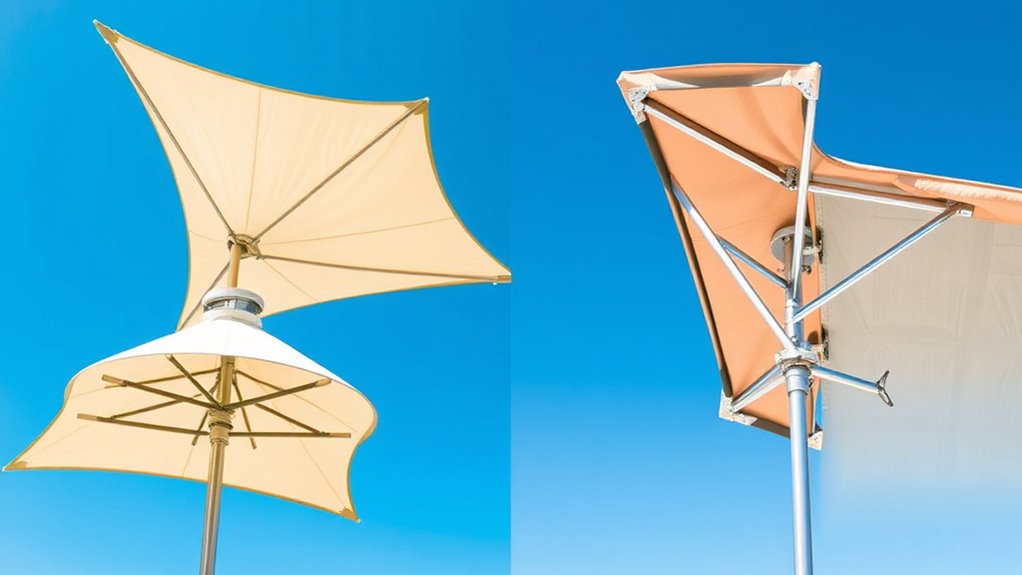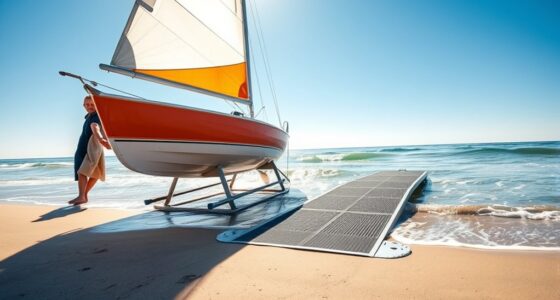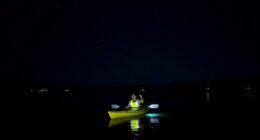Quick-deploy sun shelters come in hub and pop-up designs, each offering quick setup and portability. Hub shelters use a central frame with extendable ribs for stability, ideal for longer-term use, while pop-up shelters feature flexible frames that ‘pop’ into place for instant cover, perfect for short-term needs. Both options are lightweight and easy to transport, but their durability and wind resistance differ. Keep exploring to find out which style suits your outdoor adventures best.
Key Takeaways
- Hub shelters offer a sturdy, stable design with automatic rib extension for quick setup, while pop-up shelters rely on flexible frames that “pop” into place.
- Pop-up shelters typically deploy faster and require fewer steps, ideal for instant shade needs; hubs may need more unfolding but are more durable.
- Hubs generally provide better wind resistance and stability through reinforced frames and anchoring options compared to lightweight pop-up models.
- Pop-up shelters are more portable with lightweight materials and compact folding, suitable for frequent, on-the-go use.
- Long-term durability and weather resistance are usually higher in hub shelters due to sturdier materials and construction, offering better value over time.
Understanding the Basic Design of Hub and Pop-Up Shelters
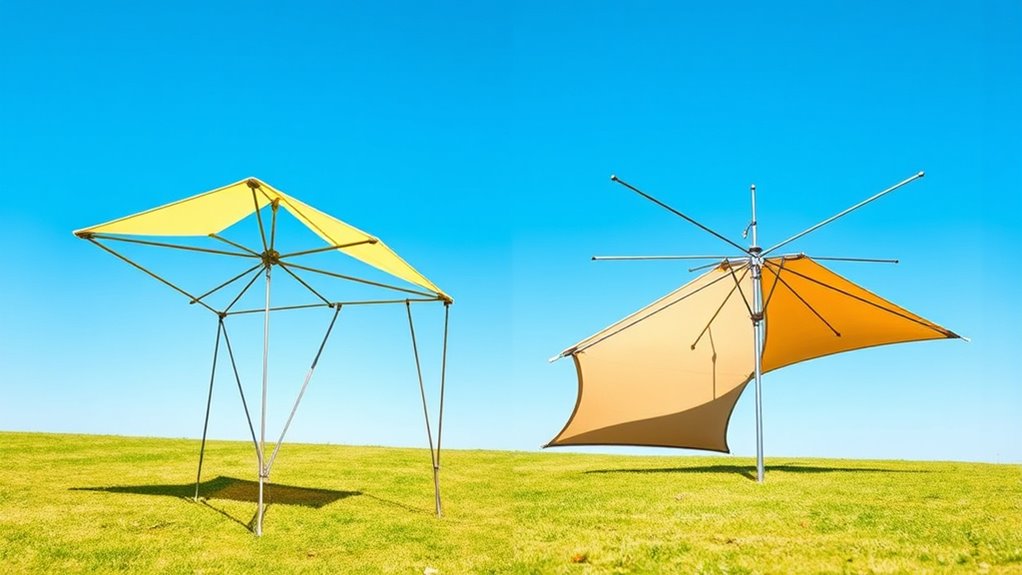
Have you ever wondered how quick-deploy sun shelters come together so rapidly? It all comes down to their simple yet effective design. Hub shelters feature a central hub with connected ribs that extend outward, creating a sturdy frame almost instantly. When you unfold the shelter, the ribs automatically spread out from the hub, forming a stable canopy. Pop-up shelters work similarly but rely on flexible, pre-assembled frames that “pop” into place with minimal effort. Both designs use lightweight materials, making setup straightforward. The key is their modular structure, which minimizes parts and maximizes speed. With just a few quick movements, you transform a compact package into a fully functional shelter. This basic design principle guarantees you’re protected from the sun in no time.
Ease of Setup and Takedown Procedures
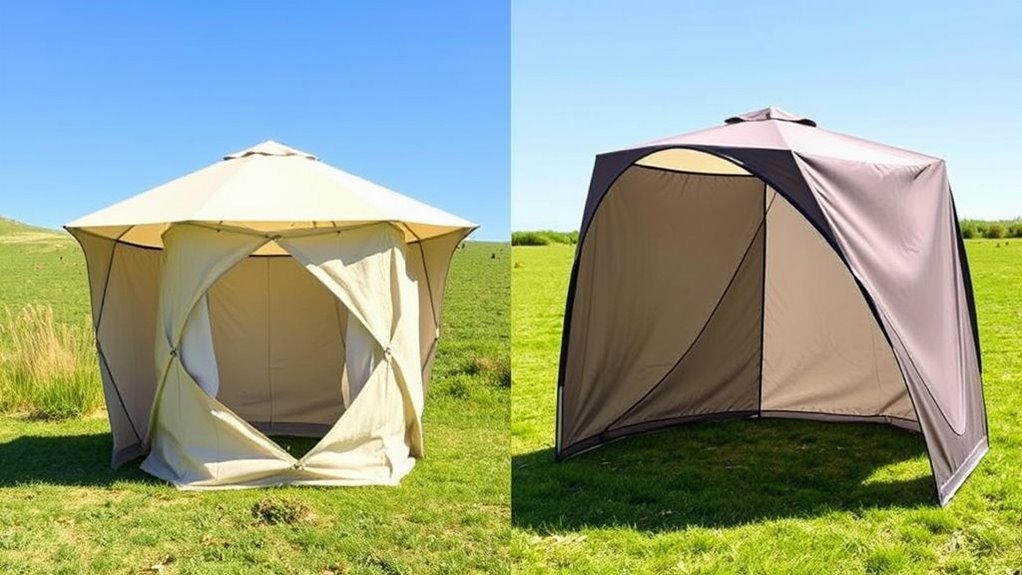
Setting up and taking down quick-deploy sun shelters is designed to be effortless, allowing you to spend less time assembling and more time enjoying your outdoor activities. With hub shelters, you typically unfold the frame, extend the poles, and secure the canopy, often with minimal steps. Pop-up shelters, on the other hand, use a pre-assembled frame that simply springs into shape when released from a carrying case, making setup almost instant. Takedown is equally straightforward: collapse the shelter, fold it into its compact form, and store it away. Both designs prioritize simplicity, but hub shelters may require a few extra steps to secure the frame properly. Understanding the ease of setup procedures can help you choose the right shelter for your specific needs. Moreover, the design features of each type can influence how quickly and comfortably you can deploy or pack away your shelter. Incorporating features like lightweight materials and reinforced joints can further enhance the portability and durability of your sun shelter. Additionally, considering the ventilation options can improve comfort during hot days and ensure proper airflow inside the shelter.
Portability and Weight Considerations
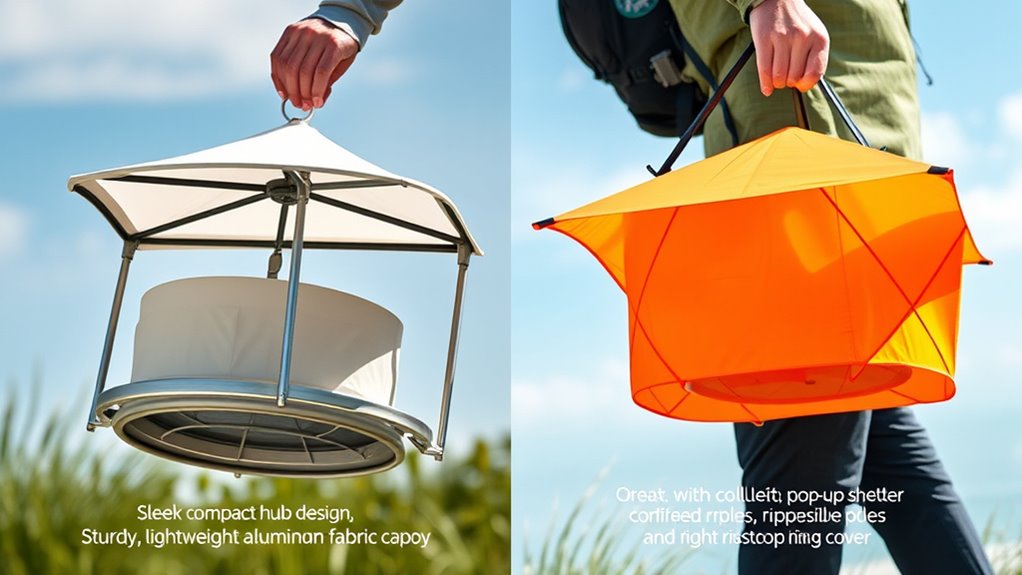
When choosing a sun shelter, you’ll want to take into account how easy it is to carry and pack. Look at the folding mechanisms and size when packed, as these affect portability. Also, keep in mind the material’s durability and weight to guarantee it’s practical for your needs. Regularly inspecting the equipment components ensures the shelter remains functional and reliable during use. Additionally, considering the material quality can help prevent damage from environmental factors and extend the lifespan of the shelter. Incorporating market research into different shelter designs can help you identify features that improve user convenience and durability. Implementing risk management strategies, such as choosing reliable materials and secure fastening methods, can further enhance the shelter’s resilience against adverse conditions. Incorporating protective styling options, such as crochet or fabric embellishments, can also enhance your shelter’s aesthetic appeal and personalization.
Folding Mechanisms and Sizes
Folding mechanisms and sizes play a crucial role in ensuring your sun shelter is easy to carry and set up. A compact, well-designed folding system allows you to quickly collapse the shelter without struggle, saving time and effort. Hub-style shelters often have simple folding frames that lock into place, making deployment straightforward, while pop-up designs typically spring into shape with minimal adjustment. Consider the size when folded; a smaller package fits more easily into your backpack or car trunk. Some shelters feature telescoping poles or collapsible ribs for reduced bulk. The key is balancing a size that’s compact enough for portability while still providing enough space when unfolded. Choosing the right folding mechanism can make your setup quicker and your pack lighter.
Material Durability and Weight
Choosing the right materials for your sun shelter directly impacts its durability and weight, which are key for portability and long-term use. Lightweight fabrics like polyester or nylon offer easy transport while providing decent UV protection, but they may wear faster over time. For increased durability, look for materials with high denier ratings or added UV-resistant coatings, even if they add weight. Frame materials also matter: aluminum is lighter and rust-resistant, making it ideal for frequent use, whereas steel offers strength but adds weight and potential corrosion issues. Balancing durability with weight ensures your shelter stays sturdy without becoming cumbersome to carry. Additionally, understanding Vetted – Flat Iron Bike vulnerabilities can help you select weather-resistant and secure materials for long-term outdoor shelter use. Ultimately, selecting quality, lightweight materials helps you set up quickly and enjoy longer-lasting protection wherever you go. Material durability is a crucial factor to consider for long-term outdoor shelter use.
Stability and Wind Resistance
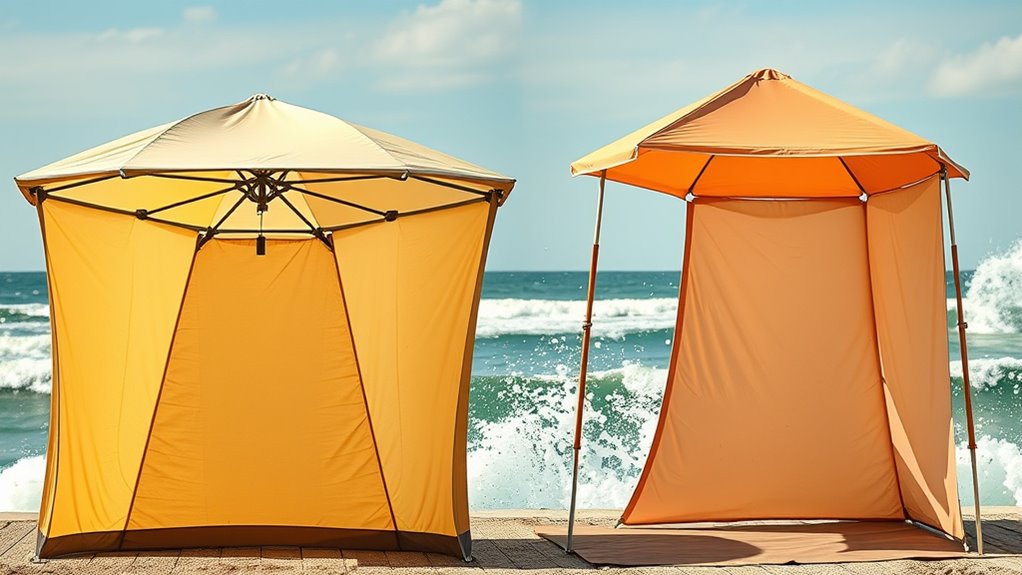
To make certain your quick-deploy sun shelter stays secure in strong winds, it’s important to take into account its stability and wind resistance features. First, check if the shelter has sturdy anchoring options like stakes or weight bags. Second, consider the frame’s material—metal frames typically offer better stability than plastic. Third, look for features such as reinforced corners or wind panels that improve wind resistance. Fourth, evaluate the design; hub-style shelters often have a lower center of gravity, making them more resistant to tipping. Additionally, ensure the shelter’s legs are adjustable to maintain a level setup on uneven ground. Trustworthy brands and proper installation techniques can greatly influence the shelter’s ability to withstand gusty conditions. Prioritizing these aspects helps you prevent your shelter from collapsing or blowing away during gusty conditions. Using proper anchoring techniques can significantly enhance the shelter’s wind resistance and overall stability.
Space and Coverage Area
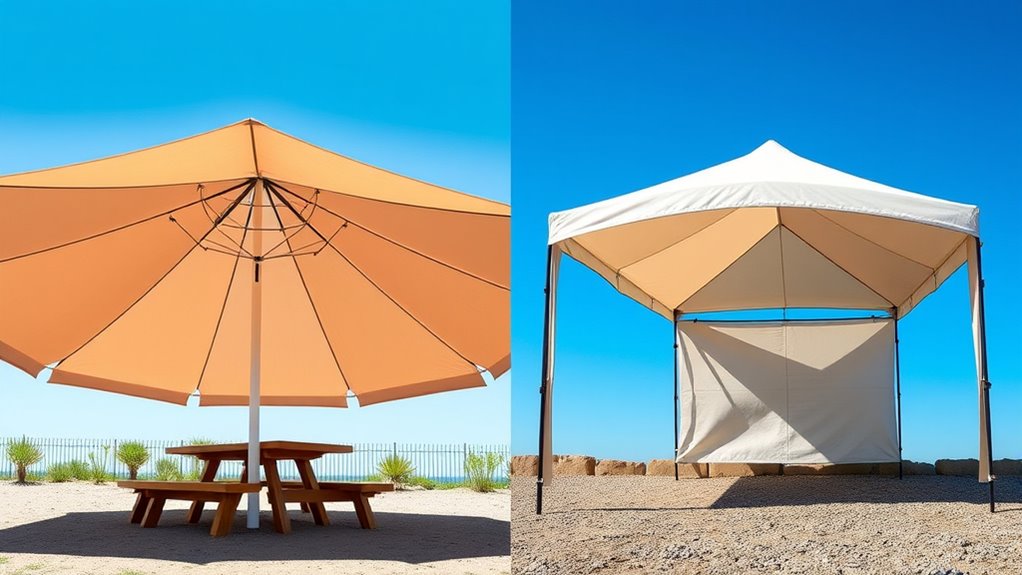
How much space do you need for your quick-deploy sun shelter? Consider how many people or items you’ll be sheltering. A hub-style shelter often offers a more compact footprint, making it easier to set up in tight spaces. It typically provides enough coverage for small groups or individual activities. Pop-up designs usually offer larger coverage areas, ideal for picnics, outdoor events, or larger groups. Measure the area where you plan to set up, including room for movement around the shelter. Keep in mind that some models have extendable canopies or side panels, increasing coverage. Think about your typical use—if you frequently host gatherings or need extra shade, a larger shelter with expanded coverage will serve you better. Proper space planning ensures comfort and functionality during outdoor activities.
Durability and Material Quality
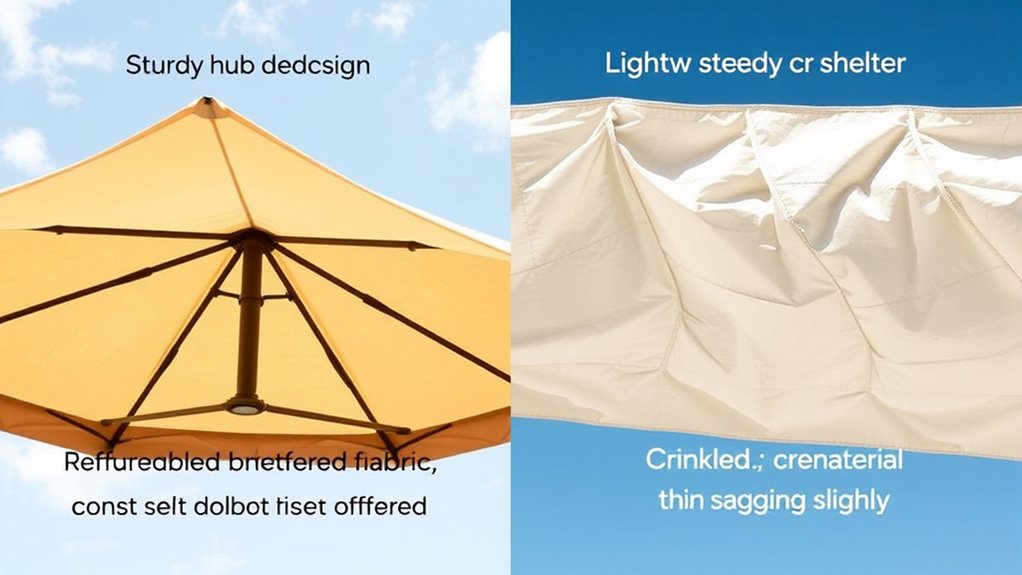
You want your sun shelter to stand up to the elements, so material strength and resistance are vital. High-quality fabrics and sturdy frames ensure it won’t break down after a few uses. Ultimately, durable materials mean more reliable protection and longer-lasting performance. Incorporating fire safety standards and sound vibrations into the design process can also enhance the structural integrity and resilience of the shelter. Additionally, selecting materials with weather-resistant properties can further improve durability and performance in various environmental conditions. Considering material testing during manufacturing can help verify these qualities before deployment.
Material Strength and Resistance
When selecting materials for quick-deploy sun shelters, durability and material quality are crucial factors that determine how well the shelter withstands harsh weather conditions and frequent setup. Material strength and resistance ensure your shelter remains intact over time. Consider these key aspects:
- Tensile Strength: Higher tensile strength means the fabric resists tearing under stress.
- Water Resistance: Look for materials with strong water-repellent coatings to prevent leaks.
- UV Resistance: Materials that resist UV rays stay durable and maintain color longer.
- Wind Resistance: Sturdy frameworks and reinforced fabrics withstand gusts without damage.
- Additionally, selecting materials with proper breathability can help prevent condensation buildup inside the shelter, enhancing comfort and longevity. Incorporating high-quality, weather-resistant fabrics can further improve the shelter’s ability to endure diverse environmental challenges. Understanding the importance of material durability ensures your shelter remains reliable over time.
- To further enhance durability, choosing corrosion-resistant components can prevent deterioration caused by exposure to moisture and salt air. Using UV-protected materials can also help preserve the fabric’s appearance and integrity over extended periods. Prioritize these factors to ensure your shelter endures and performs reliably, no matter the weather.
Wear and Tear Longevity
Choosing high-quality materials is essential because they determine how well your sun shelter withstands prolonged use and frequent setup. Durable fabrics like polyester with UV-resistant coatings resist fading, tearing, and weather damage, extending the shelter’s lifespan. Strong frame materials such as aluminum or steel prevent bending or rusting over time, maintaining stability after repeated use. Look for reinforced seams and heavy-duty zippers, which resist wear from regular opening and closing. Properly finished edges and corrosion-resistant hardware also contribute to longevity. Additionally, selecting materials with weather-resistant properties ensures your shelter remains resilient against environmental conditions. When you select a sun shelter built with quality materials, you reduce the risk of tears, breakdowns, or rust, ensuring it performs reliably season after season. Investing in durability means less replacement and hassle, giving you consistent protection whenever you need it.
Storage and Transportation Convenience
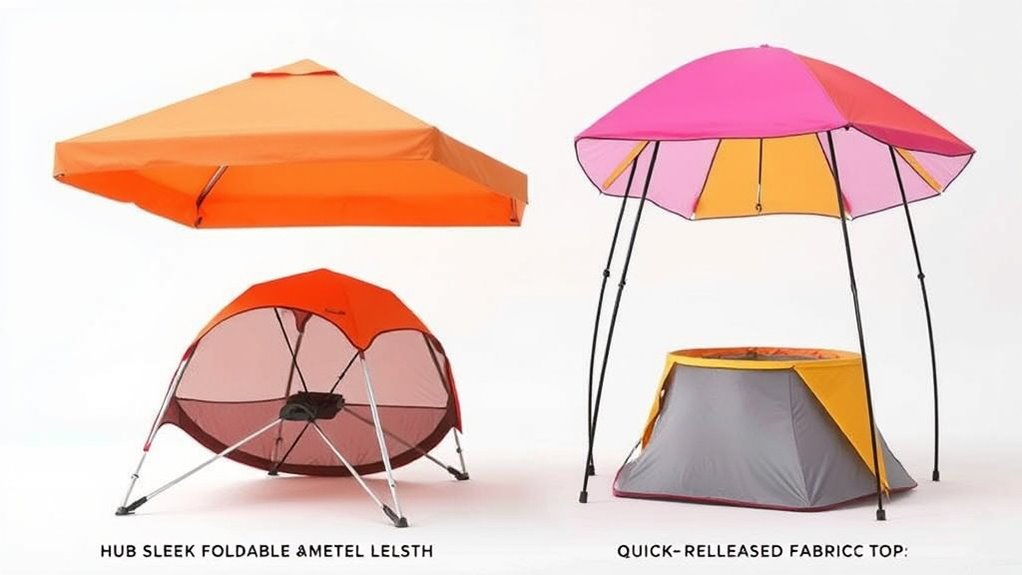
Because quick-deploy sun shelters are designed for portability, their storage and transportation are straightforward and hassle-free. You’ll find that both hub and pop-up models are easy to carry and store, making setup at different locations simple. To maximize convenience, consider these key features:
- Compact folding design that fits into a carry bag or backpack
- Lightweight materials reducing overall weight for easy handling
- Minimal assembly steps, often just unfolding or unfolding parts
- Durable cases or totes that protect the shelter during transit
- Cookie management options that allow you to customize your browsing experience and control data collection during transportation or setup
These features ensure you can quickly move your shelter from storage to setup without fuss. Whether you’re heading to the beach, park, or backyard, the convenience of transporting your quick-deploy sun shelter is a major advantage, saving you time and effort.
Cost Differences and Value for Money
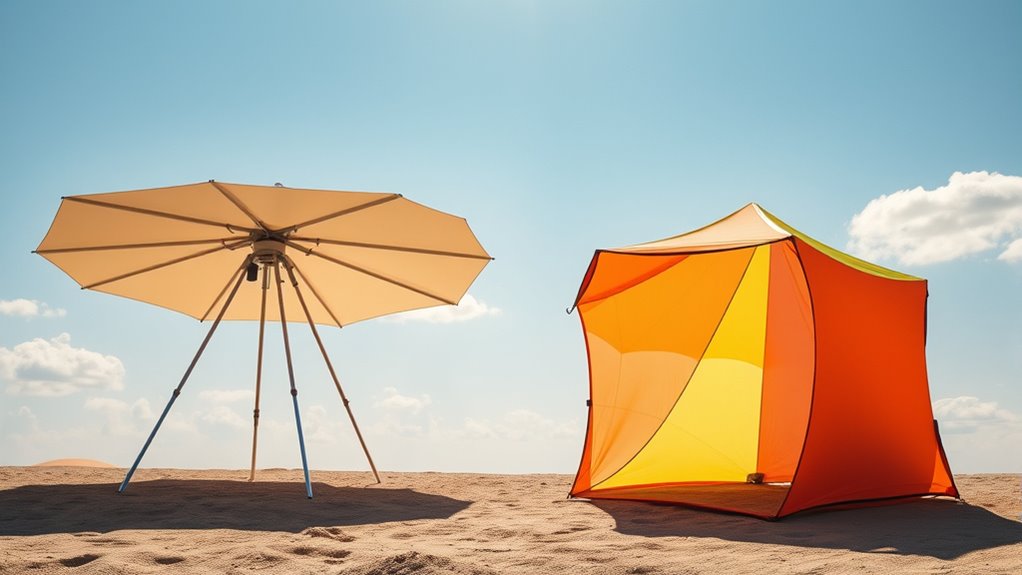
While quick-deploy sun shelters excel in portability and ease of use, their costs can vary considerably based on features, materials, and brand reputation. Hub designs tend to be more durable but come with higher upfront prices, offering long-term value. Pop-up shelters are usually cheaper initially but may require replacements sooner. To help you compare, here’s a quick breakdown:
| Feature | Hub Shelter | Pop-up Shelter |
|---|---|---|
| Initial Cost | Higher | Lower |
| Durability | More durable | Less durable |
| Longevity | Longer lifespan | Shorter lifespan |
| Maintenance | Lower maintenance | Higher maintenance |
| Value for Money | Better long-term | Cost-effective short-term |
Choosing depends on your budget and how often you’ll use it.
Ideal Use Cases and Environments
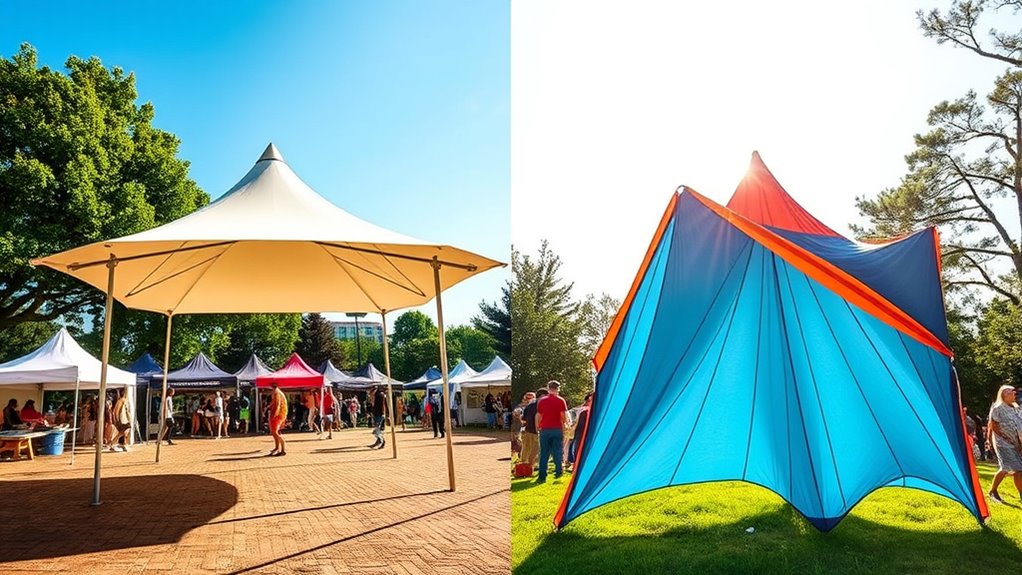
Quick-deploy sun shelters are ideal for situations where portability and rapid setup are priorities. You’ll find them perfect in environments where quick shade is essential. Consider these use cases:
- Outdoor events – markets, festivals, or sporting events needing swift shelter assembly.
- Emergency relief – providing immediate shade and cover in disaster zones.
- Camping trips – setting up quickly at sites without complex equipment.
- Construction sites – offering temporary protection for workers and materials.
These shelters excel when you need a reliable, portable solution that saves time and effort. They’re designed for environments where speed matters and conditions can change rapidly. Whether for short-term gatherings or urgent needs, these shelters adapt easily, making them indispensable in versatile outdoor settings.
Tips for Choosing the Right Shelter for Your Needs
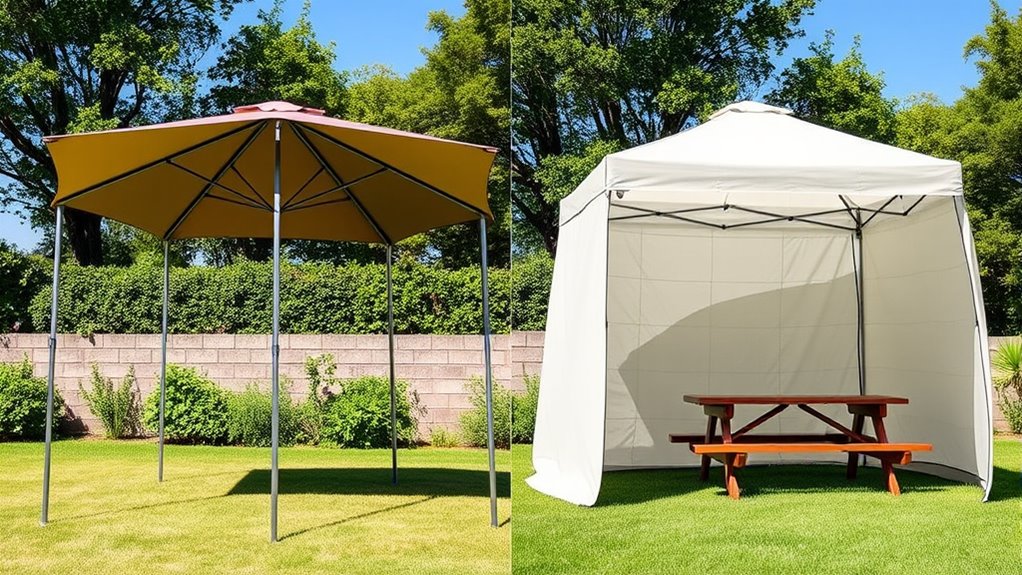
Choosing the right shelter depends on your specific needs and the environment you’ll be using it in. First, consider how often you’ll deploy it. If you need quick setup and portability, a pop-up design might suit you best. For more stability and durability in harsh weather, a hub shelter with sturdy framing could be ideal. Think about space requirements—do you need room for multiple people or gear? Also, evaluate the ease of assembly; if you’re often on the move, a lightweight, easy-to-assemble option saves time. Weather resistance is key—look for features like waterproof fabric and UV protection. Finally, consider budget and longevity. Investing in a high-quality shelter may cost more upfront but provides better protection and longer lifespan, making it a smarter choice for frequent use.
Frequently Asked Questions
How Long Does Each Shelter Type Typically Last?
When asking about how long each shelter type lasts, you’re looking at durability and material quality. Generally, hub shelters tend to last longer, often several years, since they’re built with sturdy frames and weather-resistant fabrics. Pop-up shelters might last around one to three seasons because they’re designed for quick setup and portability, but with proper care, some can extend their lifespan. Your choice depends on how often and where you plan to use them.
Can These Shelters Be Customized With Branding or Logos?
Think of customizing your shelter like adding a splash of color to a blank canvas. Yes, you can personalize these shelters with branding or logos. Most manufacturers offer options for custom graphics, ensuring your brand stands out. You can choose from various materials and placements to match your style. This way, your shelter becomes more than just protection—it turns into a mobile billboard that captures attention effortlessly.
Are There Any Safety Concerns With Certain Materials?
When choosing a sun shelter, you should consider safety concerns related to the materials used. Some fabrics and frames may be flammable or degrade quickly when exposed to sunlight and weather. Always check for certifications like fire resistance and UV protection. You need to select durable, non-toxic, and weather-resistant materials to guarantee safety and longevity. Proper maintenance and regular inspections help prevent accidents and prolong the shelter’s lifespan.
How Do Weather Conditions Affect Setup and Stability?
Weather conditions critically impact your sun shelter’s setup and stability. High winds can cause instability, so make sure you anchor your shelter securely and avoid setting up in gusty conditions. Heavy rain might add weight and pressure, risking collapse if the structure isn’t designed for it. Always check weather forecasts before deploying, and adjust your setup accordingly to keep your shelter safe and stable in varying weather.
What Maintenance Is Required to Prolong Shelter Lifespan?
Did you know regular maintenance can extend your shelter’s lifespan by up to 30%? To keep it in top shape, you should routinely clean the fabric with mild soap and water, check for tears or rust, and tighten any loose fittings. Protect it from harsh weather when not in use, and store it properly during off-seasons. These simple steps make certain your shelter stays durable and reliable for years.
Conclusion
When choosing between hub and pop-up sun shelters, consider your specific needs. Did you know that pop-up shelters can set up in under a minute, making them perfect for quick outings? If portability and ease are your priorities, a pop-up might be the way to go. But for more stability and coverage, a hub shelter could serve you better. Whatever you choose, ensuring it fits your environment will keep your outdoor experience enjoyable and hassle-free.

